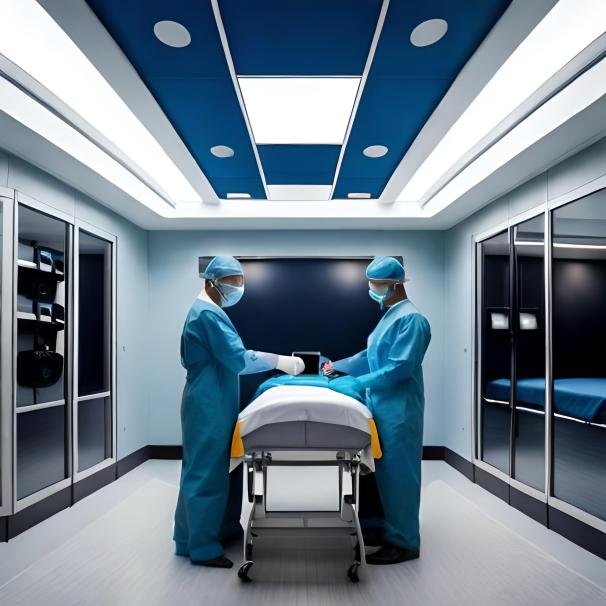
Are you thinking of getting laparoscopic surgery? Or maybe you’re just interested in this cutting-edge surgical procedure transforming the medical industry. You don’t need to look any further since we’ll take you on a tour through the ins and outs of laparoscopic surgery. In this thorough guide, we’ll examine the main features of this minimally invasive surgery and provide you with all the information you need to know.
Advantages of Laparoscopic Surgery
Keyhole surgery, sometimes called laparoscopic surgery, has many benefits over conventional open surgery.
Its minimally invasive aspect, which enables smaller incisions and less scarring, is one of the key advantages. This not only causes the patient to experience less pain and suffering, but it also has the added benefit of promoting quicker healing and shorter hospital stays.
Furthermore, laparoscopic surgery often reduces blood loss, which minimizes the need for blood transfusions.
Laparoscopic cameras’ enhanced visualization enables surgeons to execute treatments more accurately, reducing the chance of harm to surrounding tissues and organs.
The decreased chance of postoperative problems is another important benefit of laparoscopic surgery.
Laparoscopic surgery has been demonstrated to have a reduced incidence of infection, hernia development, and other problems than open surgery. This is caused in part by the use of specialized equipment and smaller, less traumatic incisions.
Laparoscopic surgery also often reduces postoperative discomfort and agony, enabling patients to return to regular activities more rapidly. These benefits lead to a better overall healthcare experience while also enhancing patient outcomes.
Laparoscopic Surgery vs. Traditional Open Surgery
Laparoscopic surgery has many benefits, but it is crucial to know how it varies from conventional open surgery. In open surgery, the operating site is accessed by a big incision, while laparoscopic surgery uses a series of tiny incisions to introduce specialized equipment and a camera.
The surgeon then carries out the surgery while they watch a monitor display a magnified, high-definition picture of the surgical site. Compared to open surgery, this minimally invasive method provides less tissue damage and quicker recovery.
Not all treatments, nevertheless, can be carried out laparoscopically. The intricacy of the medicine, the patient’s general health, and the surgeon’s experience all have a role in how feasible laparoscopic surgery is.
Open surgery may still be the best option in certain circumstances. Speaking with a licensed surgeon who can evaluate your unique problem and suggest the best surgical course of action is crucial.
Common Laparoscopic Procedures
A variety of medical professions and problems may be treated using laparoscopic surgery.
The gallbladder removal with laparoscopic cholecystectomy is one of the most popular laparoscopic surgeries. Gallstones, gallbladder inflammation, and other disorders connected to the gallbladder are the most common problems treated with this surgery.
Removing the appendix with a laparoscopic appendectomy is another regularly used laparoscopic surgery. Appendicitis, a disease marked by appendix inflammation, is often treated with this.
Laparoscopic surgery is employed in gynecology, urology, and other surgical specialties in addition to these gastrointestinal operations. Laparoscopic hysterectomy, for instance, is a less invasive method of removing the uterus that is often used to address diseases like uterine fibroids or endometriosis.
For urological treatments like nephrectomy (removal of the kidney), prostatectomy (removal of the prostate gland), or cystectomy (removal of the bladder), laparoscopic surgery is sometimes employed.
These are just a few of the many laparoscopic operations that are accessible. The precise surgical treatment advised for you will depend on your health status and the surgeon’s experience level.
Preparing for Laparoscopic Surgery
Laparoscopic surgery requires numerous crucial procedures in advance to guarantee a safe and effective operation. Your surgeon will thoroughly review your medical history and perform any required preparatory tests before your operation. These examinations might include blood testing, imaging studies, or other diagnostic techniques. Any drugs you are presently taking, and any allergies or underlying medical issues must be disclosed to your surgeon.
You may be told to adhere to certain food restrictions or stop taking specific medicines the days before your operation. You’ll get thorough instructions from your physician on how to get ready for the surgery. It is crucial to adhere to the following guidelines carefully for the best surgical results and to reduce the risk of problems.
You will normally be requested to arrive at the hospital or surgical facility on the day of your operation several hours before the planned procedure. You’ll get detailed instructions on preparing for surgery, including fasting, showering, and dressing. It would be best if you had a responsible adult with you since you won’t be able to drive yourself home following the procedure.
The Laparoscopic Surgery Process
There are numerous crucial phases in the laparoscopic surgery process, each intended to guarantee a secure and effective operation. As soon as you enter the operating room, anesthesia will be administered to keep you relaxed and pain-free during the procedure. The precise surgery and your health will determine the kind of anesthesia utilized. Before the process, your surgeon will review your anesthesia choices with you.
Small incisions, usually measuring between 0.5 and 1.5 centimeters in length, will be made in the targeted regions once the anesthesia has taken effect. The abdominal cavity is then inflated with carbon dioxide gas to give the surgeon additional room to operate. The organs can be seen and handled more clearly as a result.
Then, specialized laparoscopic tools, including a camera, will be implanted via the incisions. The surgeon can navigate the treatment accurately thanks to the camera’s high-definition view of the surgical site. Additional tools are employed to manipulate tissues, cut, dissect, or suture when necessary.
Using the pictures obtained by the camera, the surgeon will watch the process on a video display. This real-time visualization ensures the accuracy and safety of the procedure. The tools are taken out when the treatment is finished, and sutures or adhesive strips are used to seal the wounds.
Recovery and Aftercare for Laparoscopic Surgery
Laparoscopic surgery recovery and aftercare will vary based on the precise treatment and individual considerations. In comparison to open surgery, laparoscopic surgery often provides quicker recovery periods. You will be attentively watched in the recovery room after the surgery until you are awake and stable. You could feel discomfort or agony, which your surgeon can treat by prescribing painkillers.
After laparoscopic surgery, patients often return to their routines within a few days to a week. Nevertheless, it’s crucial to adhere to your surgeon’s postoperative recommendations and gradually raise your level of exercise as directed. You could be told to avoid vigorous or heavy lifting for some time.
Bruising, swelling, and soreness at the surgery site are common throughout the healing process. However, it’s crucial to contact your surgeon immediately if you detect any indications of infection, such as a rise in redness or temperature or drainage from the incisions.
Potential Risks and Complications of Laparoscopic Surgery
Laparoscopic surgery has several risks and possible problems, just like any surgical treatment. Even though there are fewer hazards overall than with open surgery, it’s still crucial to be aware of them. Infection, bleeding, and damage to adjacent structures are typical dangers. Correct surgical skills and attention to sterile standards may often reduce these hazards.
Complications, including organ perforation, blood artery damage, or postoperative hernia development, are uncommon. Before the treatment, you must go through these possible hazards with your physician. Additionally, your surgeon will advise you on reducing these risks and what symptoms to look out for while recovering.
Choosing a Qualified Laparoscopic Surgeon
A safe and effective operation requires selecting a trained laparoscopic surgeon. It is crucial to consider a surgeon’s training, experience, and proficiency in laparoscopic surgery when making your choice. Choose a surgeon with a track record of doing laparoscopic surgeries and who is board certified.
Consider also asking your primary care physician or other dependable healthcare providers for suggestions. They may provide insightful advice and direct you to a respected surgeon. During your consultation, don’t be afraid to ask questions to ensure you’re at ease and confident in your surgeon’s skills.
Frequently Asked Questions
Will I have scars after laparoscopic surgery?
Even though laparoscopic surgery is less invasive and only requires a few tiny incisions, there may still be some scarring. These scars, however, usually heal slowly and disappear over time. Your surgeon will use all means possible to reduce scarring and provide the best possible aesthetic results.
When can I return to work after laparoscopic surgery?
It will take a certain amount of time to go back to work, depending on the surgery that was done and personal considerations. After laparoscopic surgery, most patients may usually return to sedentary employment in a week or two. But physically taxing occupations could need more time to recuperate. When it's safe to return to work, you should discuss this with your surgeon.
Conclusion
Laparoscopic surgery has transformed the practice of medicine and offers several advantages over open surgery. Laparoscopic surgery has become popular among many patients and doctors because of its smaller incisions, decreased scarring, quicker recovery periods, and lower risk of problems.
Laparoscopic surgery continues to lead the path for improvements in contemporary medicine with its broad variety of applications across numerous medical specialties. It is crucial to speak with a trained surgeon before undergoing laparoscopic surgery so they can evaluate your unique situation and suggest the best course of action.
You may make educated choices about your healthcare and start down a path to better health and well-being by being aware of the benefits, dangers, and recovery period related to laparoscopic surgery.



